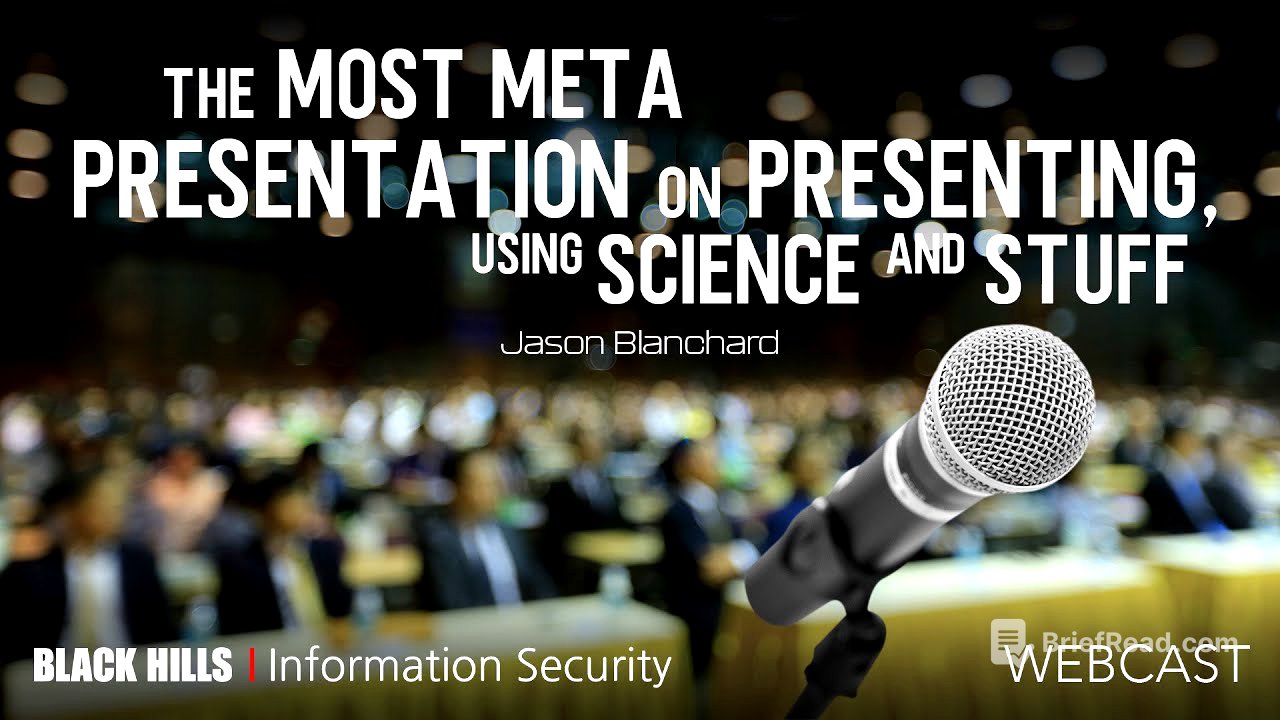TLDR;
This presentation provides a comprehensive guide on how to effectively share knowledge with others through presentations, incorporating elements of storytelling, understanding the human brain, and managing personal anxieties. It emphasizes the importance of structure, pacing, and authenticity in presentations, while also addressing common fears and self-doubt. The key takeaway is to never deny someone the opportunity to learn from your experiences and insights.
- Storytelling and structure are fundamental to engaging presentations.
- Understanding how the human brain processes information can improve pacing and delivery.
- Authenticity and acknowledging personal vulnerabilities can create a stronger connection with the audience.
FEATURE PRESENTATION: How to Share Your Knowledge With Others [0:00]
The presentation begins by acknowledging that many people experience anxiety related to public speaking, ranging from mild discomfort to intense fear. The speaker shares his personal feelings of wanting to share knowledge but also disliking the vulnerability and judgment that come with presenting. He addresses the common "what ifs" that arise when considering public speaking, particularly the fear of not being good enough. The core message is that everyone has valuable knowledge to share, and withholding it denies others the opportunity to learn and benefit.
I do, I don’t. [3:15]
The speaker shares his conflicting feelings about presenting, expressing his desire to share knowledge and see its impact, but also his anxiety about being judged. He admits to feeling edgy and needing everything to be perfect before a presentation. Despite these anxieties, he emphasizes that the desire to share knowledge outweighs the discomfort, encouraging the audience to recognize that their fears are manageable.
Am I enough? [7:15]
The presenter addresses the common fears associated with public speaking, particularly the underlying question of "What if I'm not enough?". He explains that these fears are natural, stemming from the brain's protective mechanisms against potential dangers to one's reputation or professional standing. The speaker underscores the importance of pushing past these fears to share one's knowledge, as withholding it denies others the opportunity to learn and grow.
Who am I? [9:16]
The speaker provides background on his experience in content creation, video editing for the U.S. Army, teaching filmmaking, owning a comic book store, and creating content for SANS Institute and Black Hills Information Security. He emphasizes his understanding of how to manipulate human feelings through video editing and storytelling. He shares his experience speaking in church in Korea. He also streams on Twitch to practice presenting and speaking.
Born storytellers. [14:16]
The speaker asserts that everyone is a born storyteller, equipped with a set of favorite stories they share in social situations. He illustrates this point with a personal anecdote about a bat in his house becoming a new top-five story. He recalls his childhood playing with G.I. Joe figures, creating elaborate scenarios and narratives. He shares a tip for parents to tell their children stories, even using familiar plots like Star Wars, as children initially accept these tales without question. The speaker emphasizes that all stories follow a structure: a hook, beginning, middle, climax, and end.
The Human Brain: Structure [20:13]
The speaker transitions to discussing the structure of the human brain and how it relates to storytelling and presentations. He reveals that nearly all movies follow a similar formula, hitting key moments at predictable intervals within a 90-minute timeframe: a hook at minute three, an inciting incident by minute ten, the hero's quest starting at minute 30, initial success by minute 45, a major setback between minutes 60 and 75, a turning point at minute 75, and a climactic sequence leading to a quick resolution. Examples from "Ghostbusters," "The Lion King," and "Top Gun" illustrate this structure.
The Human Brain: Pacing [27:48]
The speaker discusses pacing and how the human brain processes visual and auditory information. He explains that the average cut in movies and TV shows is three seconds, mirroring the brain's natural "blinking" or shifting focus. It takes the human brain three seconds to recognize, interpret, and relate new information to past experiences. If information is presented too slowly (beyond four or five seconds), the audience may lose focus and start thinking about unrelated things. Conversely, rapid cuts (one or two seconds) create excitement and engagement but leave less time for personal reflection. The speaker reveals that he uses pacing to keep audience engaged.
The Human Brain: Show vs Tell [37:06]
The speaker explains the difference between showing and telling in presentations. Showing involves providing specific details and visuals, leaving little room for interpretation, while telling allows the audience to fill in the blanks with their own imagination. He uses the example of describing a "yellow house" versus showing a picture of one. He shares his experience working with first-time filmmakers, emphasizing the importance of showing rather than just telling to avoid misinterpretations.
Filters [42:45]
The speaker emphasizes that everyone has unique filters through which they perceive the world, meaning that each audience member will experience a presentation differently based on their background, experiences, and personal biases. He acknowledges that he is not enough for everyone, and it's okay if some people don't connect with his message or choose to leave. The key is to focus on connecting with those who do resonate with the information and can benefit from it.
How to apply this? [45:09]
The speaker provides practical advice on applying the concepts discussed to future presentations. He recommends starting with a blank sheet of paper and outlining the structure: hook, beginning, middle, climax, and end. For the hook, ask the audience a question to immediately engage them. In the beginning, take the audience on a personal quest, explaining why the topic matters to you. In the middle, share three key learnings from your quest. In the climactic part, explain how the audience can apply what you've learned to their own lives. Conclude by summarizing key points, inspiring the audience, and providing a final takeaway.
Q & A [55:28]
The speaker answers questions from the audience, including how to manage time constraints, find images for presentations, avoid relying on PowerPoint as a crutch, adapt presentation styles for live versus virtual settings, and deal with untimely questions. He recommends Toastmasters. He also recommends books "Poke the Box" by Seth Godin and "In the Blink of an Eye" by Walter Murch.


![[자막뉴스] "일하러 나가기 두렵다"...벌써부터 불안한 조짐 / YTN](https://wm-img.halpindev.com/p-briefread_c-10_b-10/urlb/aHR0cDovL2ltZy55b3V0dWJlLmNvbS92aS9aSW8tU2tweVVJNC9ocWRlZmF1bHQuanBn.jpg)






